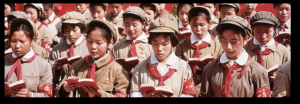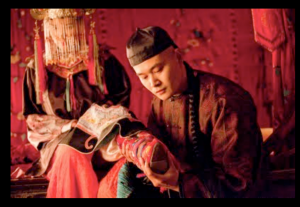
China: Through the Looking Glass
Met Gala
In the Met Gala exhibit China: Through the Looking Glass, an amalgam of fashion pieces as art was presented in a decontextualized and culture sensitive setting. In the photograph above, the exhibit displays a traditional Chinese porcelain vase next to two aesthetically similar but clearly distinct dresses. This specific grouping of two different forms of art in three objects epitomizes the idea of surfaces as an expression of beauty and art, the redefining of orientalism, and the concept of using culturally and traditionally significant objects as inspiration for fantastical embodiments of symbols and signs respectfully removed from the original context. break this long sentence and make it sound clear.
Objects: Each of the three objects in the photograph above has an individual purpose and context, but together they function in conjunction as a gallery art exhibit. It is clear that there are three objects in a line presented to the audience, a porcelain vase, an elegant gown, and a more exploratory/extravagant dress. Though these objects would rarely be associated with each other on a day-to-day basis, it is obvious that the two pieces of apparel derive its symbols from the porcelain vase. All three items are the same two colors: blue and white. And all three items project a sense of tacit fragility and admirable delicacy. While the porcelain vase’s material itself is shatter-able, the first dress projects delicacy through its soft silk material and tight hem, the second dress projects fragility through the multitude of gems on the bodice and the elaborate layers of chiffon ruffles. The vase is too intricate for casual use just as the dresses are too sophisticated for wear. Thus, all three display pieces are not for use but for aesthetic appreciation.
Placement: China: Through the Looking Glass claims that a main concept of the exhibit is to promote a communication between the east and the west without appropriating or orientalizing the east. The photograph above is representative of the aforementioned idea in the placement of the objects. Clearly the porcelain vase is inherently Chinese, while the two dresses speak more of western influence in style and material. However, all of these objects are of similar height. The curators have purposefully elevated the porcelain vase so that it is not degraded or looked down upon, but seen as an equal. Furthermore, the vase is place a few feet in front of the two mannequins, while temporally distant from the viewer it is proximally more tangible. This closeness of the vase disallows orientalization as it is brought into the reality of the viewer as well as the two dresses.
Lighting: The deliberate lighting of the exhibit also reconfirms the goal of decontextualization. As we can see, the porcelain vase while physically closer to the viewer, is shrouded in shade while the light directly shines on the two dresses. Initially, this automatically brings the viewer’s attention to the dresses. The viewer will first perceive the two dresses and then shift their focus to the porcelain. This process of interpretation lets the viewer recognize the dresses as the main art exhibit, and then by shifting their gaze to the vase, the viewer understands that the vase was the source of inspiration. Also, the three objects on display contrasts with the dark tapestry in the background. Because the foreground differs so greatly from the background in color, material, lighting, and time period, the decontextualization of the exhibit is even more profound. The dynamic between the tapestry and the three art pieces emphasizes that the vase and dresses are each a solitary form of art regardless of context.
The carefully selected three items showcased in the exhibit along with the particular lighting and placement of the art is a paradigm of what China: Through the Looking Glass wants to convey to the audience. It simultaneously evokes artistic awe and admiration, demonstrates a reverent mode of communication between China and her western counterparts, and also shows the possibility of extracting unique symbols without importing the whole framework of the symbol.
yes, the three pieces in display reflect incorporation between source of inspiration and outcome of creation without contextualization. The transition from a classical flower vase to modern fashion dresses does contrast China as Other and West innovation, however.





